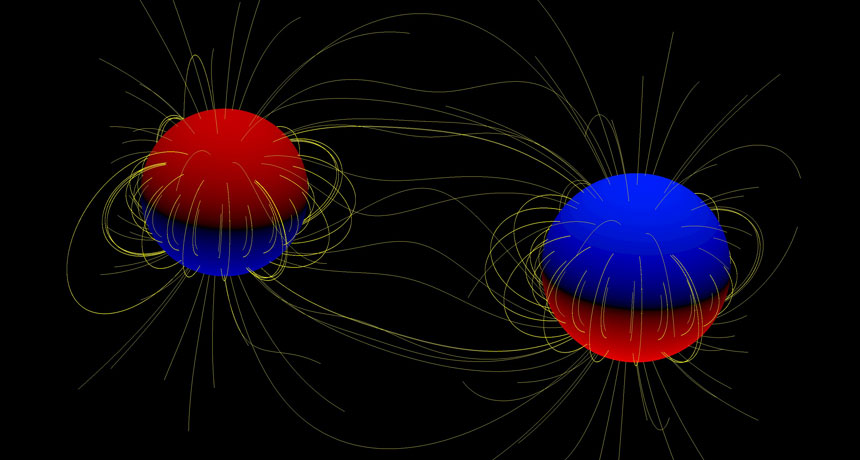Magnetic stars could have created LIGO’s massive black holes

To create a heavy black hole, it might help to start with a massive magnetic star.
Strong magnetic fields could help stem the flow of gas from a heavyweight star, leaving behind enough material to form hefty black holes, a new study suggests. A pair of such magnetic stars could be responsible for giving birth to the black hole duo that created recently detected gravitational waves, researchers report online December 1 in Monthly Notices of the Royal Astronomical Society.
The shake-up in spacetime that was picked up the Advanced Laser Interferometric Gravitational-Wave Observatory, or LIGO, in 2015 came from a collision between two black holes weighing about 29 and 36 times the mass of the sun (SN: 3/5/16, p. 6). Such plump black holes were surprising. The creation of a big black hole requires the explosive death of a gargantuan star. But weighty stars are so bright that the light blows gas into space.
“These massive stars can lose up to half their mass to their dense stellar winds,” says study coauthor Véronique Petit, an astrophysicist at Florida Institute of Technology in Melbourne. That leaves only enough mass to make a more modest black hole.
Having a paucity of elements heavier than helium is one way a massive star might retain gas. Atoms such as carbon, oxygen and iron present large targets to the radiation streaming from a star. Photons nudge these atoms along, generating strong stellar winds. A lack of heavy elements could keep these winds in check.
Petit and colleagues have proposed another idea: intense magnetic fields that might redirect escaping gas back onto the star. Observations in recent years have led to the discovery that about 10 percent of stellar heavyweights have powerful magnetic fields, some exceeding 10,000 gauss (the sun’s magnetic field is, on average, closer to 1 gauss).
Computer simulations allowed researchers to see how much mass a star could retain if it were blanketed by magnetic fields. Magnetism is an effective levee, they found. A magnetic star that starts off with 80 times as much mass as the sun, for example, ends its life about 20 suns heavier than a similarly massive one that’s not magnetic.
“This is an interesting alternative hypothesis for how stars can end up holding onto more of their mass, so they can form such heavy black holes,” says Vicky Kalogera, an astrophysicist at Northwestern University in Evanston, Ill. But, she cautions, “the mechanism is somewhat speculative.” Astronomers don’t have a good handle yet on how magnetic fields change as a star evolves, she says, particularly as the star approaches the end of its life.
“It’s going to be hard to test our hypothesis,” Petit says. Pinpointing the host galaxy of a future collision between obese black holes might help, but that’s fraught with ambiguity. If the galaxy is rich in heavy elements, then perhaps magnetic fields are needed to hold back the flow of gas from gigantic stars. But that doesn’t mean the black holes were born in that environment. They could also have formed early in the universe, says Petit, when their galaxy had fewer heavy elements, in which case magnetic fields might not be necessary.